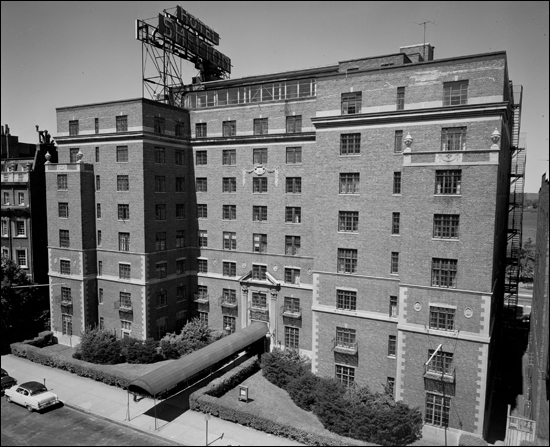The Real Bars of "The Iceman Cometh"

Photo © Chicago Tribune.
Playwright Eugene O’Neill wrote “The Iceman Cometh,” his opus of lost dreams and disillusionment set in a seedy bar, after decades of drinking in bars just like the one Harry Hope runs in O’Neill’s drama.
O'Neill captured the atmosphere inside those bars when he has a character in "Iceman" say of Harry Hope's, "It's the No-Chance Saloon. It's Bedrock Bar, the End-of-the-Line Cafe, the Bottom-of-the-Sea Rathskeller! It's the last harbor. No one here has to worry about where they're going next, because there is no farther they can go.''
Two of the bars O'Neill frequented were particular favorites: Jimmy-the-Priest’s on New York City’s waterfront (252 Fulton St.), and the Golden Swan in Greenwich Village (6th Ave. and West 4th St.).
Jimmy-the-Priest's
O’Neill, a born-and-bred New Yorker, returned to the city in 1912, after three years at sea. He found his way to Jimmy-the-Priest’s, a bar-cum-flophouse where he rented a room for $3 a month, and spent his days drinking downstairs.


Photo © Linda Lear Center for Special Collections and Archives, Connecticut College (top), and the New York Public Library (bottom).
Jimmy’s was a classic dive bar--it opened at noon and served cheap whiskey and five-cent droughts of beer. Its patrons included sailors, stevedores, and workers from the wholesale produce exchange across the street. For atmosphere, you could find the occasional newspaper-man or writer. O'Neill’s friend, Dorothy Day, said of the people at Jimmy’s, “No one ever wanted to go to bed, and no one ever wished to be alone.”
O’Neill said that his drinking buddies at Jimmy’s were “the best friends I ever had. I learned at Jimmy-the-Priest’s not to sit in judgment on people.” Years later, O’Neill would bring those friends to life; the eclectic characters in “Iceman” include a dirty cop, anarchists, prostitutes, a law-school graduate, a con man, and a couple of literary types.
The “Jimmy” of Jimmy-the-Priest's was James J. Condon. He wasn’t a priest. In fact, O’Neill described him as cynical and callous. But he had a soft spot for anyone down on their luck--he served a free lunch of hot soup to lodgers and regulars, forbid fights in his bar, and was patient with down-on-their-luck patrons. Condon became one of the models for Harry Hope in “Iceman.”


Photo © NYC Municipal Archives.
O'Neill Becomes a Playwright
It turns out that 1912 was the lowest point of O’Neill’s life. His three-year marriage to Kathleen Jenkins broke up, and he was adrift, without a plan for the future. Despondent, he tried to kill himself by mixing whisky with sleeping pills (Veronal). But another derelict, James Findlater Byth, a Broadway press agent and bar regular, found O’Neill passed out in his room and revived him. Byth had been a public relations rep for O'Neill's actor father, James O'Neill, Sr., and he lived in the room next to O'Neill at Jimmy's. O’Neill modeled the drunken ex-journalist James (“Jimmy Tomorrow”) Cameron in “Iceman” on him.
After his suicide attempt, O’Neill moved to New London, Connecticut, and took a job at a newspaper. He almost died in Connecticut, too, but this time from tuberculosis. He was hospitalized for five months, where he read Swedish author August Strindberg’s autobiographical plays. "It was reading his plays," O'Neill said later, "that, above all else, first gave me the vision of what modern drama could be, and first inspired me with the urge to write for the theater myself."
The Golden Swan
In 1914, O’Neill’s father financed the publication of five O’Neill plays. Two were produced by the Provincetown Playhouse, a theater in Greenwich Village. That same year, O’Neill moved to Cambridge, Mass., to attend a playwriting class at Harvard (his tuition was paid for by his father).

Photo © NYC Municipal Archives.
Afterward, O'Neill moved to a rooming house in New York City’s bohemian Greenwich Village. He planned to return to Harvard in the fall of 1915, but the call of alcohol got the better of him once more. He spent his days at the second watering hole that figured prominently in character development for “Iceman,” the Golden Swan.
The Swan, nicknamed the Hell Hole by regulars, was owned by an ex-boxer named Thomas Wallace, who became the second model for Harry Hope. Wallace was a crusty, half-blind barkeep who drank his own liquor but nevertheless kept an eye out for his diverse clientele, from writers and artists (including John Sloan, head of the Ashcan School of American painters) to members of the Hudson Dusters, a local gang, to the prostitutes who plied their trade in the Swan’s back room. O’Neill would return from rehearsals of his plays at the Provincetown Playhouse, get drunk at the Swan, and then recite the poem “The Hound of Heaven.”


Photos © Byron Company (top) and Boston University Archives (bottom).
The "Iceman" Cometh...
Into Being
It wasn't until years later, in 1939, that O’Neill wrote “The Iceman Cometh,” though he set the play in 1912, the worst year of his life. He spent five months reliving his darkest days, “locking myself in with my memories,” he said. O’Neill biographer Barbara Gelb said that, while writing "Iceman,” “O'Neill retreated deeper and deeper into his past, into a time when he spent countless hours and endless days drinking in a saloon and rooming house on Fulton Street called Jimmy-the-Priest's, sharing his fellow-derelicts' pipe dreams, their 'hopeless hope' of a better tomorrow that never came.”
A year after “Iceman” was first staged, in 1947, O’Neill contracted an unknown neurological disorder (originally thought to have been Parkinson’s disease) that curtailed any further writing. He died of pneumonia in 1953, at age 65.

Photo © Google Maps.
